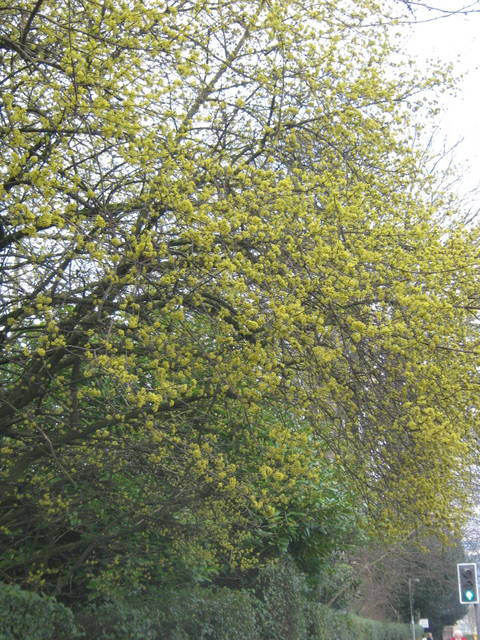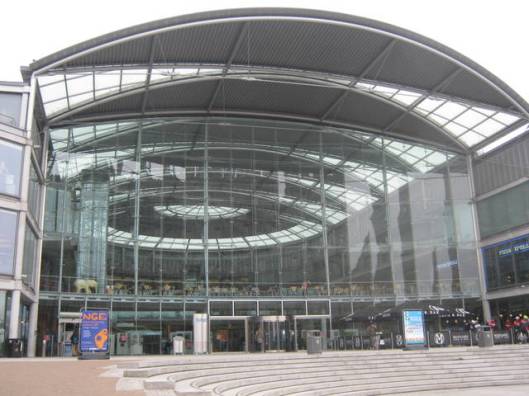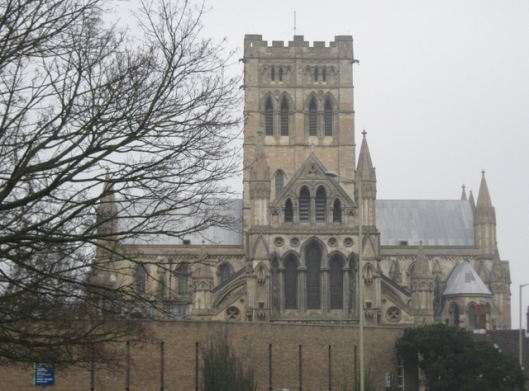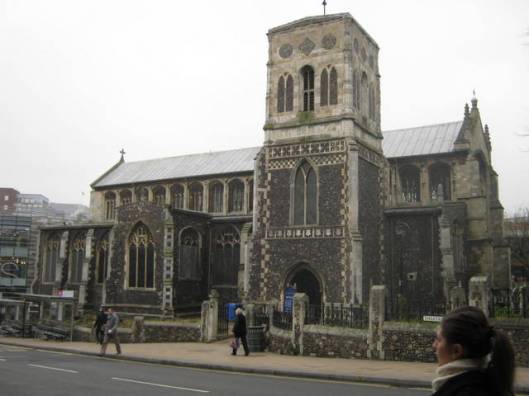Tags
Chapel Field, Chapelfield Gardens, Chapelfield Gardens Bandstand, City Walls, Cornus mas, Norwich, Roman Catholic Cathedral, St Stephen's church, The Assembly House, The Crescent, The Forum, walking
I took this short walk in Norwich on a dull cold day last spring. I began my walk near the Assembly House.
This building was designed and built by the architect Thomas Ivory in 1794 and, as its name suggests, was a place where the local gentry could assemble and be amused and entertained by recitals, displays and dances. One notable ball was in celebration of Nelson’s victory off the Cape of Trafalgar in 1805. A waxworks exhibition from Madame Tussaud’s was hosted here in 1825 and Franz Liszt the composer gave a concert in 1840. The building incorporates the layout of a previous building – the medieval college of St Mary in the Field.
It has been used as a dance academy, a cinema and, during the Second World War, it was an army office. It was restored in 1995 but almost immediately afterwards was severely damaged by an electrical fire. With the aid of photographs taken at the instigation of a trustee during WW2, the house was reconstructed and today it appears exactly as it did when it was first built. It is used as a restaurant and hosts exhibitions, concerts, conferences and weddings, almost the same kind of use it was put to in its heyday.
Opposite the Assembly House is the Forum, though the large entrance seen in the photo above is on the further side of the building.
Norwich’s Central Library was located on this spot until it was destroyed by fire in 1994 and this new building, designed by Sir Michael Hopkins, not only gave the library a new home but also was built to mark the Millennium in the East of England. The main section of the building is an enclosing horseshoe shape. It is made from hand-made load-bearing bricks and has many windows.
As well as The Millennium Library (the public library) the Forum houses a children’s library, the Norfolk Heritage Centre, the Norfolk Record Office and a business library. The 2nd Air Division Memorial Library is also here; it pays tribute to the thousands of American airmen who were based in East Anglia during WW2. There are over 4000 books covering all aspects of American life and culture with a specialist section dedicated to the 2nd Air Division.
Many other organisations have a base in the Forum. BBC East has its studios in part of the building; there is a Forum shop, a café bar and a pizza restaurant. The Tourist Information Centre is here, as is MINT – a charity which helps young people gain the skills and contacts they need to find employment. MINT is run by City College Norwich where my daughter studies. ‘BBC Voices’ provides film-making and radio-editing workshops throughout the Eastern Region for free. There is a digital gallery – the Fusion Screen – which gives free screenings of work by artists, and a 120-seat auditorium called The Curve. The Forum runs regular events and there is a venue hire facility.
Not far from The Forum is Chapelfield Gardens which takes its name from the chapel of St Mary in the Field. The chapel (built where the Assembly House is now) was founded in the 13th century by John le Brun and soon acquired many generous benefactors. It became a college and the premises were expanded. In 1406 the citizens of Norwich claimed 4.5 acres of ground that belonged to the Chapel and this land began to be called Chapel Field. In the 16th century it was leased with its cherry yard and dove house to notable citizens and then, after a proclamation in 1578 it was used as an open area for mustering the trained bands, archers or the artillery. It was the ‘fit place’ to charge guns with shot and powder for the exercise of shooting. The Lord Lieutenant had his ‘City Tent’ there for the general musters and the yearly reviews of the city regiment took place there in the 17th century.
The Field was first surrounded by fencing in 1707 and the main walks were laid out by Sir Thomas Churchman who leased the land in 1746. The tree planting began then too. A large water reservoir (about 300 yards in circumference) was dug in part of the Field in 1792 and was filled in again in 1854 when larger reservoirs were built elsewhere by the newly established Waterworks Company. The reservoir in the Field had been used as a skating pond by the people of the city and it was much missed when it went. For a few years the Field declined into a rough area where children played, washerwomen hung out their linen and where sheep were grazed. Eventually, new iron palisades were erected in 1866 and in 1877 a landscape gardener was employed to make the Field into a beauty spot. The newly laid-out gardens were opened by the mayor in 1880.
This lovely Victorian bandstand in the middle of Chapelfield Gardens is still in use. During WW2 Glenn Miller visited Norwich and gave a concert here in 1944.
I then walked along Chapel Field Road which follows the line of the old City Walls. As you can see from these photos the new and the old rub shoulders in Norwich. The weather had also improved by this time!
Building work on the City Walls began in 1294 and took 50 years to complete mainly due to complaints about the cost being levied for their construction. They were completed in 1343 after a very generous donation by a Norwich tradesman, Richard Spynk who was rewarded by the Corporation by being ‘quit all tallages, tasks and costs’ for both he and his heirs forever. When the walls were completed they had 12 gates, now all gone. Ber Street gate – taken down in 1807, Bishop’s Gate – taken down in 1791, Brazen Doors or Newgate, taken down in 1793, Conisford Gate, at the south end of King Street – taken down in 1793, Heigham Gate or Hell Gate – fell down in the 18th century, Magdalen Gate – taken down in 1808, Pockthorpe Gate – taken down in 1792, St Augustine’s Gate – taken down in 1794, St Giles’ Gate – taken down in 1792, St Martin’s or Coslany Gate – taken down in 1793,St Stephen’s or Nedham Gate – taken down in 1793, Westwick or St Benedict’s Gate – taken down in 1793.

A beautiful Cornus mas growing in a garden on the opposite side of the road to the City Walls was in flower
The houses were built in about 1820 and are a mixture of terraced, semi-detached and detached houses, many of which are listed.
St Stephen’s church has it’s tower over the porch on the side of the church. I hope to visit this church later in the year and write about it in more detail as I also hope to write about the RC Cathedral.
Thanks for visiting!














I find it hard to fathom just how long many of the buildings and other structures have lasted there, even if renovated. Here, a building built in the 1800’s is extremely old, not many survive. Not only that, some one has recorded the history of everything there, for you to relate to us in your posts. That’s something else Americans didn’t do, as the people here were expanding into what they thought was a wilderness at the time. I really appreciate the research that you put into your posts for that reason. Keep them coming!
LikeLiked by 1 person
Thank-you very much for your kind comment Jerry. I think it would have been a miracle if someone had had the time to record anything they had done in the States in the early 1800s! A lot of the information had to be gleaned from word-of-mouth anecdotes passed on through families. I have read a few accounts written by British visitors to the States during the 19th century – Charles Dickens for example visited in 1842. My husband recently read an account written by Isabella Bird a 40 year-0ld woman from England who travelled alone in the Rockies in 1873! Crazy woman!
LikeLiked by 1 person
Thank you for the history lesson, Clare! Yes, amazing to see how well things were built and how durable without modern tools and equipment.
I’m off for a week. Catch up with you after the 24th!
LikeLiked by 1 person
Thank-you Lavinia! Hope you have a lovely break.
LikeLike
Always interesting to go walking with you, thanks for the tour.
LikeLiked by 1 person
Thank-you very much Susan.
LikeLike
I enjoyed your walk around Norwich Clare and the Cornus mas is stunning, thats a tree I’d love to have space for here.
LikeLiked by 1 person
Thank-you Julie. I would love one too. The one in Norwich is a stunner! The photo was taken last year on the 18th of March. When I drove past the tree the other day it was almost fully out already.
LikeLiked by 1 person
I enjoyed this walk through history and the present time. Have you ever taken people on guided city tours? I think you would be a natural. 🙂
LikeLiked by 1 person
Ha ha! I think I would be absolutely tongue-tied!
LikeLiked by 1 person
Really? Well, in the unlikely event of a visit from me, I would love to have you guide me around. 🙂
LikeLiked by 1 person
How kind! I’m sure I could manage to walk with a friend. 🙂
LikeLiked by 1 person
Excellent.
LikeLiked by 1 person
🙂
LikeLiked by 1 person
I have never been to Norwich – I hadn’t realised there was so much to see.
LikeLiked by 1 person
Thank-you Rachel. I love it there – it isn’t a large city and everything is within a short walk.
LikeLike
Oh, those old walls are wonderful! And how nice that they have been incorporated with the new and maintained. We Americans can’t quite wrap our heads around structures that old!
LikeLiked by 1 person
Thank-you Kerry. We are very fortunate to have so much ‘history’ about us though it can be difficult to live with at times!
LikeLike
You’re a terrific tour guide, Clare! For someone who struggled with history in high school, you make it much more interesting. Great photos!
LikeLiked by 1 person
Thank-you Jill. I love history though found it so dry and boring at school – all those laws and dates to remember; yuk!
LikeLike
Clare, how interesting – you’re such a good tour guide! The Assembly House is a lovely building; I could picture Jane Austen’s characters there. And across the street, such a different style! With a library inside! I will look forward to the RC church, being of that persuasion myself. 😉
LikeLiked by 1 person
Thank-you Lisa. The RC Cathedral is enormous and has some wonderful treasures in it. I hope to write something on it sometime this year.
LikeLike
It all looks so lovely and interesting. I always want to go visit all the places you write about. Thank you for sharing!
LikeLiked by 1 person
Thank-you so much – you are very kind!
LikeLiked by 1 person
Another wonderful walk review! How beautiful the new and old is incorporated! Thnaks again, for bringing us along! xo Johanna
LikeLiked by 1 person
Thank-you Johanna! You always say such nice things 🙂
LikeLike
I liked the look of your modern building among the older ones.
LikeLiked by 1 person
Thank-you, Tom.
LikeLike
Sad that the library burned! I hate to think of all the old and irreplaceable books that were lost.
It’s also too bad that they tore down all the city gates. What a lot of history gone. I wonder if they regret it.
The cornelian cherry (Cornus mas) is really amazing. I had no idea they got that big. The ones I see here are barely six feet tall, but they might be dwarf varieties. I love seeing their flowers in spring!
LikeLiked by 1 person
Thank-you Allen. I am sure many people regret the loss of the gates but it was done at a time in history when people had no sense of heritage and wanted to make our towns and cities modern and easier to travel through. We have gone too far the other way now and it is becoming increasingly difficult to build new structures or modernise anything without years of discussion! Not that I don’t love all the old buildings myself!
I remember the day the library burned down very well. So much was lost especially the archive material – very sad.
I love the Cornelian Cherry! It really is enormous and must love its location. I said to Julie earlier in the comments that the photo was taken last year on 18th March and already this year it is almost fully in bloom again.
LikeLike
I love to wallow in your history walks, you do get me wishing to explore more, I feel I have been inspired to do so now and will go to Nottingham and do just that. Nature and architecture are always nicely contrasted in your posts.
LikeLiked by 1 person
You are very kind Ste. I look forward to your impressions of Nottingham.
LikeLiked by 1 person
They won’t be half as in depth as yours but then I did take rubbish photos which I noticed when I came home. I will salvage something in the next week though.
LikeLiked by 1 person
I’m sure they’re much better than you think they are. However, you write brilliant book reviews and I have no idea where to start with one – I can’t do them!
LikeLiked by 1 person
Sometimes I just look at the page as well with no idea how to start it. I tend to find, just writing down notes usually helps and something pops up. Essentially I just blag it lol!
LikeLiked by 1 person
😀
LikeLike
Looks beautiful there
LikeLiked by 1 person
It is! Thank-you Julia.
LikeLike
Thank you for this very interesting tour, Clare. The old buildings are beautiful. We don’t have architecture like that around here. I appreciate how much time and effort you put into researching these places. 🙂
LikeLiked by 1 person
You are very kind Jane – thank-you!
LikeLiked by 1 person
The forum sounds like a great community building, loved the photos Clare, that lone traffic cone is a strange one. Were the city walls from a fully enclosed Roman city like Chester was?
LikeLiked by 1 person
Thank-you Charlotte. Yes that lone cone looks a bit sad! It did have friends but I couldn’t get them all in the photo! The city walls did enclose the whole city once but they were built in the 13th century and aren’t anywhere near as old as Chester’s walls. I have only been to Chester once and loved the walk on the walls round the city. Richard and I were only talking about Chester today and saying how we ought to go back again soon.
LikeLiked by 1 person
Clare, I was also going to tell you – if you are going to try those Jane Austen mysteries, it’s best to read them in order. ☺
LikeLiked by 1 person
Thank-you Lisa! I’ll remember 🙂
LikeLike
Lovely architecture, fascinating commentary and beautiful spring flowers – what a gorgeous walk you have taken us on here, thank you! 😀
LikeLiked by 1 person
My pleasure Liz and thank-you! 🙂
LikeLiked by 1 person
You make such a wonderful tour guide Clare! I always feel as if I am walking along with you! I really loved the Assembly House – what a beautiful building and it was really interesting to see the juxtaposition of old and new with the modern buildings and then the ancient city walls. Your research on the gates is incredible. Its just staggering to realize just how many there were and then of course there must be so much history attached to the names of them all too. It was really sad to hear of the library burning down. It’s interesting because you tend to accept fires destroying buildings as part of history but to read that it only happened in 1994 seems unbelievable. How sad that they were unable to save it – it must have been quite a fire.
Thank you – lovely tour!
– Kate
LikeLiked by 1 person
Thank-you Kate. It was awful – I remember it very clearly
http://news.bbc.co.uk/onthisday/hi/dates/stories/august/1/newsid_2526000/2526839.stm
Both the fire at the library and the fire in the Assembly House started as electrical faults and both fires happened within a few months of each other. I am glad you liked the tour!
Clare
LikeLike
Thanks for the tour, Clare. The buildings are interesting, as are the gates. And that bandstand is so much like ones we see here in Canada.
LikeLiked by 1 person
Thank-you Cynthia. I like the old traditional bandstand. Most here have been demolished long ago.
LikeLiked by 1 person
Such a lovely post! I remember, as a kid, going to the British library here in Calcutta and would leaf through the magazine..i think it was called, Countryside or something, it has all the photographs of old mansions which were up for sale…and I would dream of one day staying in one of those grand buildings! 🙂
LikeLiked by 1 person
Thank-you very much! Countrylife Magazine – oh yes! Gorgeous photos of houses costing millions of pounds! 😀
LikeLiked by 1 person
Haha…yes yes…that must be it…God…those houses looked fabulous!!! 😀
LikeLiked by 1 person
😀
LikeLiked by 1 person
I so enjoyed following along with your walking tour – so much history there!
LikeLiked by 1 person
Thank-you Sheryl!
LikeLike